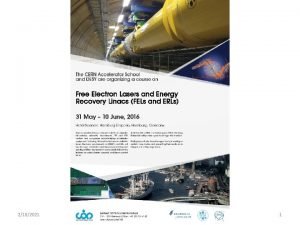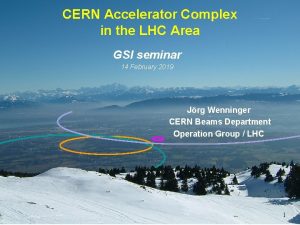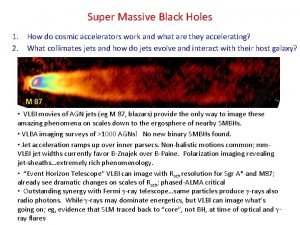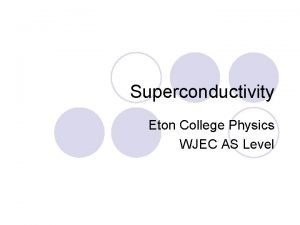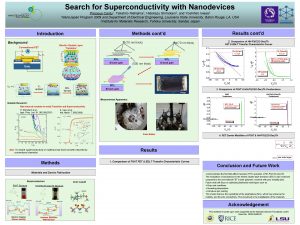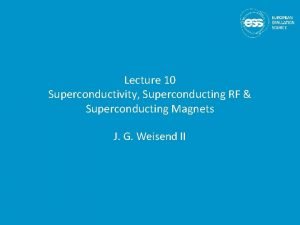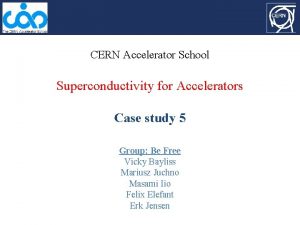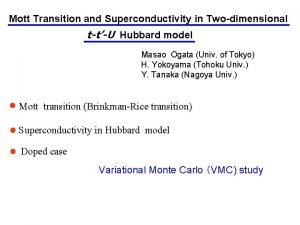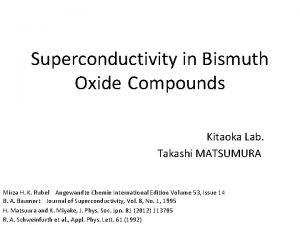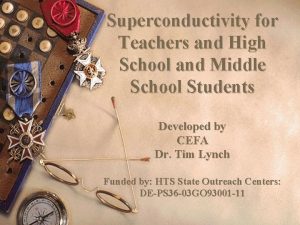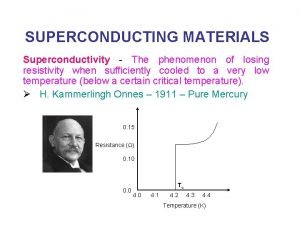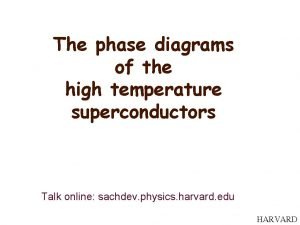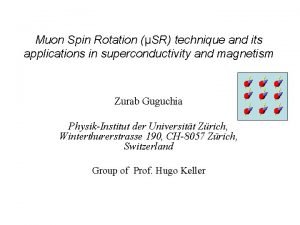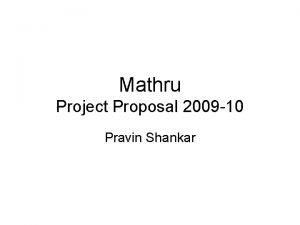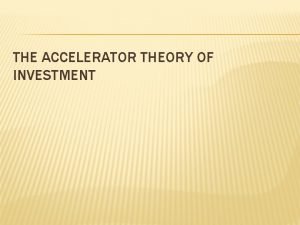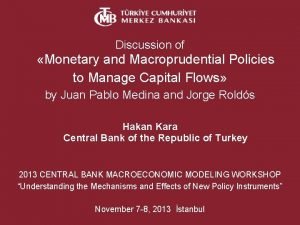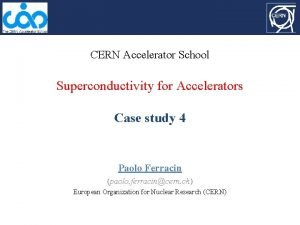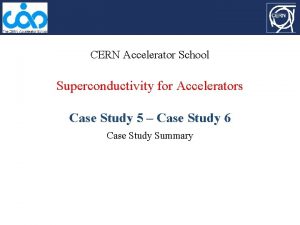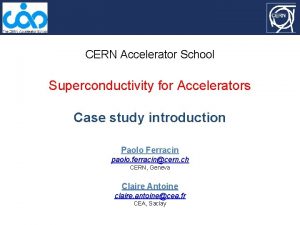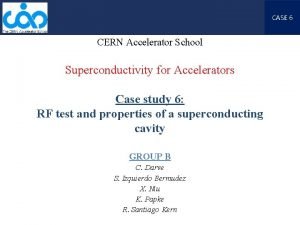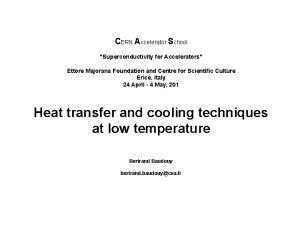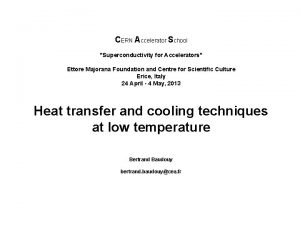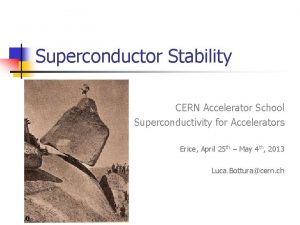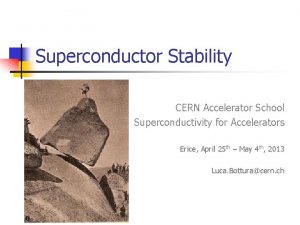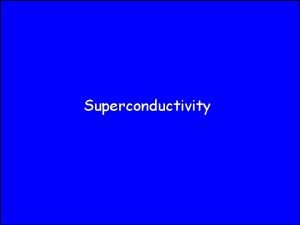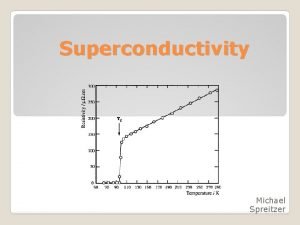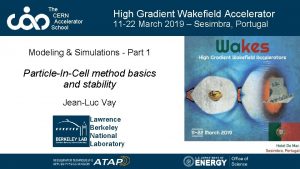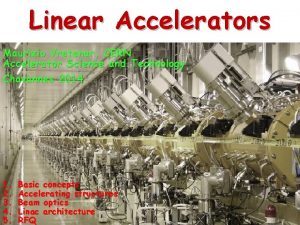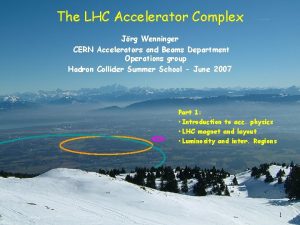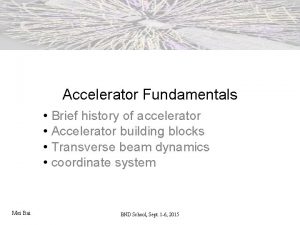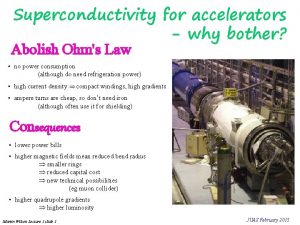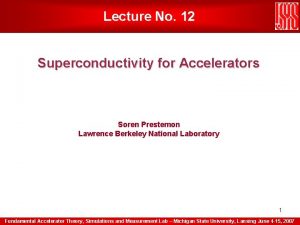CERN Accelerator School Superconductivity for Accelerators Case study































- Slides: 31

CERN Accelerator School Superconductivity for Accelerators Case study 3 Paolo Ferracin (paolo. ferracin@cern. ch) European Organization for Nuclear Research (CERN)

Case study 3 High field - large aperture magnet for a cable test facility Introduction High field (Bbore>10 T) magnets are needed to upgrade existing accelerators in Europe and to prepare for new projects on a longer timescale. Nb 3 Sn is today the right candidate to meet those objectives, because of its superconducting properties and its industrial availability. On the very long term, further upgrades could require dipole magnets with a field of around 20 Tesla (T): a possible solution is to combine an outer Nb 3 Sn coil with an inner coil of High Critical Temperature (HTS) conductor, both contributing to the field. In addition, an high-field dipole magnet with a large aperture could be used to upgrade the Fresca test facility at CERN, in the aim of meeting the strong need to qualify conductor at higher fields. Goal Design a superconducting dipole with an 100 mm aperture and capable of reaching 15 T at 1. 9 K (~90% of Iss). Superconductivity for Accelerators, Erice, Italy, 25 April - 4 May, 2013 Case study 3 2

Case study 3 High field - large aperture magnet for a cable test facility Questions 1. 2. Determine maximum gradient and coil size (using sector coil scaling laws) Define strands and cable parameters 1. 2. 3. 4. 3. Determine load-line (no iron) and “short sample” conditions 1. 4. 2. 6. 7. 8. Compute jsc_ss , jo_ss , Iss , Bpeak_ss Determine “operational” conditions (80% of Iss ) and margins 1. 5. Strand diameter and number of strands Cu to SC ratio and pitch angle Cable width, cable mid-thickness and insulation thickness Filling factor κ Compute jsc_op, jo_op , Iop , Bpeak_op Compute T, jsc , Bpeak margins Compare “short sample”, “operational” conditions and margins if the same design uses Nb-Ti superconducting technology Define a possible coil lay-out to minimize field errors Determine e. m forces Fx and Fy and the accumulated stress on the coil mid-plane in the operational conditions (80% of Iss ) Evaluate dimension iron yoke, collars and shrinking cylinder, assuming that the support structure is designed to reach 90% of Iss Superconductivity for Accelerators, Erice, Italy, 25 April - 4 May, 2013 Case study 3 3

Case study 3 Additional questions Evaluate, compare, discuss, take a stand (… and justify it …) regarding the following issues High temperature superconductor: YBCO vs. Bi 2212 Superconducting coil design: block vs. cos Support structures: collar-based vs. shell-based Assembly procedure: high pre-stress vs. low pre-stress Superconductivity for Accelerators, Erice, Italy, 25 April - 4 May, 2013 Case study 3 4

Case study 3 High field - large aperture magnet for a cable test facility Questions 1. 2. Determine maximum gradient and coil size (using sector coil scaling laws) Define strands and cable parameters 1. 2. 3. 4. 3. Determine load-line (no iron) and “short sample” conditions 1. 4. 2. 6. 7. 8. Compute jsc_ss , jo_ss , Iss , Bpeak_ss Determine “operational” conditions (80% of Iss ) and margins 1. 5. Strand diameter and number of strands Cu to SC ratio and pitch angle Cable width, cable mid-thickness and insulation thickness Filling factor κ Compute jsc_op, jo_op , Iop , Bpeak_op Compute T, jsc , Bpeak margins Compare “short sample”, “operational” conditions and margins if the same design uses Nb-Ti superconducting technology Define a possible coil lay-out to minimize field errors Determine e. m forces Fx and Fy and the accumulated stress on the coil mid-plane in the operational conditions (80% of Iss ) Evaluate dimension iron yoke, collars and shrinking cylinder, assuming that the support structure is designed to reach 90% of Iss Superconductivity for Accelerators, Erice, Italy, 25 April - 4 May, 2013 Case study 3 5

Case study 3 solution Maximum field and coil size The max. field that one could reach with 60 mm wide coil is about 16. 5 T Superconductivity for Accelerators, Erice, Italy, 25 April - 4 May, 2013 Case study 3 6

Case study 3 solution Maximum gradient and coil size With a w/r of 60/50 = 1. 2 λ of 1. 04 Superconductivity for Accelerators, Erice, Italy, 25 April - 4 May, 2013 Case study 3 7

Case study 3 solution Maximum gradient and coil size Superconductivity for Accelerators, Erice, Italy, 25 April - 4 May, 2013 Case study 3 8

Case study 3 High field - large aperture magnet for a cable test facility Questions 1. 2. Determine maximum gradient and coil size (using sector coil scaling laws) Define strands and cable parameters 1. 2. 3. 4. 3. Determine load-line (no iron) and “short sample” conditions 1. 4. 2. 6. 7. 8. Compute jsc_ss , jo_ss , Iss , Bpeak_ss Determine “operational” conditions (80% of Iss ) and margins 1. 5. Strand diameter and number of strands Cu to SC ratio and pitch angle Cable width, cable mid-thickness and insulation thickness Filling factor κ Compute jsc_op, jo_op , Iop , Bpeak_op Compute T, jsc , Bpeak margins Compare “short sample”, “operational” conditions and margins if the same design uses Nb-Ti superconducting technology Define a possible coil lay-out to minimize field errors Determine e. m forces Fx and Fy and the accumulated stress on the coil mid-plane in the operational conditions (80% of Iss ) Evaluate dimension iron yoke, collars and shrinking cylinder, assuming that the support structure is designed to reach 90% of Iss Superconductivity for Accelerators, Erice, Italy, 25 April - 4 May, 2013 Case study 3 9

Case study 3 solution Cable and strand size We assume a strand diameter of 0. 80 mm Superconductivity for Accelerators, Erice, Italy, 25 April - 4 May, 2013 We assume a pitch angle of 17 Case study 3 10

Case study 3 solution Cable and strand size We assume Thick. Comp. = -12 % Width. Comp. = -1. 5 % 35 strands Ins. Thick. = 150 μm We obtain Cable width: 15 mm Cable mid-thick. : 1. 4 mm Superconductivity for Accelerators, Erice, Italy, 25 April - 4 May, 2013 Case study 3 11

Case study 3 solution Cable and strand size Summary Strand diameter = 0. 80 mm Cu to SC ratio = 1. 1 Pitch angle = 17 N strands = 35 Cable width: 15 mm Cable mid-thickness: 1. 4 mm Insulation thickness = 150 μm Area insulated conductor = 26. 0 mm 2 We obtain a filling factor k = area superconductor/area insulated cable = 0. 31 Superconductivity for Accelerators, Erice, Italy, 25 April - 4 May, 2013 Case study 3 12

Case study 3 High field - large aperture magnet for a cable test facility Questions 1. 2. Determine maximum gradient and coil size (using sector coil scaling laws) Define strands and cable parameters 1. 2. 3. 4. 3. Determine load-line (no iron) and “short sample” conditions 1. 4. 2. 6. 7. 8. Compute jsc_ss , jo_ss , Iss , Bpeak_ss Determine “operational” conditions (80% of Iss ) and margins 1. 5. Strand diameter and number of strands Cu to SC ratio and pitch angle Cable width, cable mid-thickness and insulation thickness Filling factor κ Compute jsc_op, jo_op , Iop , Bpeak_op Compute T, jsc , Bpeak margins Compare “short sample”, “operational” conditions and margins if the same design uses Nb-Ti superconducting technology Define a possible coil lay-out to minimize field errors Determine e. m forces Fx and Fy and the accumulated stress on the coil mid-plane in the operational conditions (80% of Iss ) Evaluate dimension iron yoke, collars and shrinking cylinder, assuming that the support structure is designed to reach 90% of Iss Superconductivity for Accelerators, Erice, Italy, 25 April - 4 May, 2013 Case study 3 13

Case study 3 solution Margins Let’s work now on the load-line The bore field is given by So, for a Jsc= 1000 A/mm 2 jo = jsc * k = 465 A/mm 2 Bbore = 12. 8 T Bpeak = Bbore * λ = 12. 8 * 1. 04 = 13. 3 T Superconductivity for Accelerators, Erice, Italy, 25 April - 4 May, 2013 Case study 3 14

Case study 3 solution Margins Nb 3 Sn parameterization Temperature, field, and strain dependence of Jc is given by Summers’ formula where Nb 3 Sn is 900 for = -0. 003, TCmo is 18 K, BCmo is 24 T, and CNb 3 Sn, 0 is a fitting parameter equal to 60800 AT 1/2 mm-2 for a Jc=3000 A/mm 2 at 4. 2 K and 12 T. Superconductivity for Accelerators, Erice, Italy, 25 April - 4 May, 2013 Case study 3 15

Case study 3 solution Margins Nb-Ti parameterization Temperature and field dependence of BC 2 and TC are provided by Lubell’s formulae: where BC 20 is the upper critical flux density at zero temperature (~14. 5 T), and TC 0 is critical temperature at zero field (~9. 2 K) Temperature and field dependence of Jc is given by Bottura’s formula where JC, Ref is critical current density at 4. 2 K and 5 T (~3000 A/mm 2) and CNb-Ti (27 T), Nb-Ti (0. 63), Nb-Ti (1. 0), and Nb-Ti (2. 3) are fitting parameters. Superconductivity for Accelerators, Erice, Italy, 25 April - 4 May, 2013 Case study 3 16

Case study 3 solution Margins Nb 3 Sn Let’s assume = 0. 000 The load-line intercept the critical (“short-sample” conditions) curve at jsc_ss = 1230 mm 2 jo_ss = jsc_ss * k = 381 mm 2 Iss = jo_ss * Ains_cable= 9900 A Bbore_ss = 15. 8 T Bpeak_ss = 16. 4 T Superconductivity for Accelerators, Erice, Italy, 25 April - 4 May, 2013 Case study 3 17

Case study 3 solution Margins Nb 3 Sn The operational conditions (80% of Iss) jsc_op = 984 mm 2 jo_op = jsc_op * k = 305 mm 2 Iop = jo_op * Ains_cable= 7930 A Bbore_op = 12. 7 T Bpeak_op = 13. 2 T Superconductivity for Accelerators, Erice, Italy, 25 April - 4 May, 2013 Case study 3 18

Case study 3 solution Margins Nb 3 Sn In the operational conditions (80% of Iss) 4. 6 K of T margin (3000 -984) A/mm 2 of jsc margin (17. 2 -13. 2) T of field margin Superconductivity for Accelerators, Erice, Italy, 25 April - 4 May, 2013 Case study 3 19

Case study 3 solution Margins Nb-Ti “Short-sample” conditions jsc_ss = 850 mm 2 jo_ss = jsc_ss * k = 264 mm 2 Iss = jo_ss * Ains_cable= 6900 A Bbore_ss = 11. 0 T Bpeak_ss = 11. 4 T The operational conditions (80% of Iss) jsc_op = 680 mm 2 jo_op = jsc_op * k = 244 mm 2 Iop = jo_op * Ains_cable= 6350 A Bbore_op = 8. 8 T Bpeak_op = 9. 1 T 2. 1 K of T margin (1850 -680) A/mm 2 of jsc margin (11. 5 -9. 1) T of field margin Superconductivity for Accelerators, Erice, Italy, 25 April - 4 May, 2013 Case study 3 20

Case study 3 High field - large aperture magnet for a cable test facility Questions 1. 2. Determine maximum gradient and coil size (using sector coil scaling laws) Define strands and cable parameters 1. 2. 3. 4. 3. Determine load-line (no iron) and “short sample” conditions 1. 4. 2. 6. 7. 8. Compute jsc_ss , jo_ss , Iss , Bpeak_ss Determine “operational” conditions (80% of Iss ) and margins 1. 5. Strand diameter and number of strands Cu to SC ratio and pitch angle Cable width, cable mid-thickness and insulation thickness Filling factor κ Compute jsc_op, jo_op , Iop , Bpeak_op Compute T, jsc , Bpeak margins Compare “short sample”, “operational” conditions and margins if the same design uses Nb-Ti superconducting technology Define a possible coil lay-out to minimize field errors Determine e. m forces Fx and Fy and the accumulated stress on the coil mid-plane in the operational conditions (80% of Iss ) Evaluate dimension iron yoke, collars and shrinking cylinder, assuming that the support structure is designed to reach 90% of Iss Superconductivity for Accelerators, Erice, Italy, 25 April - 4 May, 2013 Case study 3 21

Case study 3 solution Coil layout One wedge coil sets to zero b 3 and b 5 in quadrupoles ~[0°-48°, 60°-72°] ~[0°-36°, 44°-64°] Some examples Superconductivity for Accelerators, Erice, Italy, 25 April - 4 May, 2013 Case study 3 22

Case study 3 High field - large aperture magnet for a cable test facility Questions 1. 2. Determine maximum gradient and coil size (using sector coil scaling laws) Define strands and cable parameters 1. 2. 3. 4. 3. Determine load-line (no iron) and “short sample” conditions 1. 4. 2. 6. 7. 8. Compute jsc_ss , jo_ss , Iss , Bpeak_ss Determine “operational” conditions (80% of Iss ) and margins 1. 5. Strand diameter and number of strands Cu to SC ratio and pitch angle Cable width, cable mid-thickness and insulation thickness Filling factor κ Compute jsc_op, jo_op , Iop , Bpeak_op Compute T, jsc , Bpeak margins Compare “short sample”, “operational” conditions and margins if the same design uses Nb-Ti superconducting technology Define a possible coil lay-out to minimize field errors Determine e. m forces Fx and Fy and the accumulated stress on the coil midplane in the operational conditions (80% of Iss ) Evaluate dimension iron yoke, collars and shrinking cylinder, assuming that the support structure is designed to reach 90% of Iss Superconductivity for Accelerators, Erice, Italy, 25 April - 4 May, 2013 Case study 3 23

Case study 3 solution E. m. forces and stresses For a dipole sector coil, with an inner radius a 1, an outer radius a 2 and an overall current density jo , each block (quadrant) see Horizontal force outwards Vertical force towards the mid-plan In case of frictionless and “free-motion” conditions, no shear, and infinitely rigid radial support, the forces accumulated on the mid-plane produce a stress of Superconductivity for Accelerators, Erice, Italy, 25 April - 4 May, 2013 Case study 3 24

Case study 3 solution E. m. forces and stresses In the operational conditions (Bbore_op = 12. 7 T) Fx (quadrant) = +5. 68 MN/m Fy (quadrant) = -4. 89 MN/m The accumulates stress on the coil mid-plane is Superconductivity for Accelerators, Erice, Italy, 25 April - 4 May, 2013 Case study 3 25

Case study 3 High field - large aperture magnet for a cable test facility Questions 1. 2. Determine maximum gradient and coil size (using sector coil scaling laws) Define strands and cable parameters 1. 2. 3. 4. 3. Determine load-line (no iron) and “short sample” conditions 1. 4. 2. 6. 7. 8. Compute jsc_ss , jo_ss , Iss , Bpeak_ss Determine “operational” conditions (80% of Iss ) and margins 1. 5. Strand diameter and number of strands Cu to SC ratio and pitch angle Cable width, cable mid-thickness and insulation thickness Filling factor κ Compute jsc_op, jo_op , Iop , Bpeak_op Compute T, jsc , Bpeak margins Compare “short sample”, “operational” conditions and margins if the same design uses Nb-Ti superconducting technology Define a possible coil lay-out to minimize field errors Determine e. m forces Fx and Fy and the accumulated stress on the coil mid-plane in the operational conditions (80% of Iss ) Evaluate dimension iron yoke, collars and shrinking cylinder, assuming that the support structure is designed to reach 90% of Iss Superconductivity for Accelerators, Erice, Italy, 25 April - 4 May, 2013 Case study 3 26

Case study 3 solution Dimension of the yoke The iron yoke thickness can be estimated with Therefore, being Bbore = 14. 2 T (at 90% of Iss ) r = 50 mm and Bsat = 2 T we obtain tiron = ~360 mm Superconductivity for Accelerators, Erice, Italy, 25 April - 4 May, 2013 Case study 3 27

Case study 3 solution Dimension of the support structure We assume a 25 mm thick collar Images not in scale Superconductivity for Accelerators, Erice, Italy, 25 April - 4 May, 2013 Case study 3 28

Case study 3 solution Dimension of the support structure We assume that the shell will close the yoke halves with the same force as the total horizontal e. m. force at 90% of Iss Fx_total = Fx_octant * 2 = +14. 4 MN/m Assuming an azimuthal shell stress after cool-down of shell = 200 MPa The thickness of the shell is tshell = Fx_total /2/1000/ shell ~ 36 mm Superconductivity for Accelerators, Erice, Italy, 25 April - 4 May, 2013 Case study 3 29

Case study 3 solution Magnet cross-section Coil inner radius: 50 mm Coil outer radius: 110 mm The operational conditions (80% of Iss) jsc_op = 984 mm 2 jo_op = jsc_op * k = 305 mm 2 Iop = jo_op * Ains_cable= 7930 A Bbore_op = 12. 7 T Bpeak_op = 13. 2 T Collar thickness: 25 mm Yoke thickness: 330 mm Shell thickness: 36 mm OD: 1 m Superconductivity for Accelerators, Erice, Italy, 25 April - 4 May, 2013 Case study 3 30

Comparison Superconductivity for Accelerators, Erice, Italy, 25 April - 4 May, 2013 Case study 3 31
 Cern accelerator school 2021
Cern accelerator school 2021 Cern accelerator complex
Cern accelerator complex The long-term future of particle accelerators
The long-term future of particle accelerators Accelerators computer architecture
Accelerators computer architecture Slidetodoc
Slidetodoc Good to great technology accelerators
Good to great technology accelerators Good to great technology accelerators
Good to great technology accelerators Cosmic super accelerators
Cosmic super accelerators Analytics query accelerators
Analytics query accelerators Superconductivity a level physics
Superconductivity a level physics Superconductivity
Superconductivity Superconductivity
Superconductivity Superconductivity
Superconductivity Superconductivity
Superconductivity Hubbard
Hubbard Superconductivity
Superconductivity Superconductivity
Superconductivity Superconductivity definition
Superconductivity definition Persistent current in superconductor
Persistent current in superconductor Superconductivity
Superconductivity Superconductivity
Superconductivity Best case worst case average case
Best case worst case average case Crm failure case study
Crm failure case study Glennan building cwru
Glennan building cwru Mathru blind school case study
Mathru blind school case study Transformational leadership inventory
Transformational leadership inventory Criticism of accelerator theory of investment
Criticism of accelerator theory of investment Biztalk accelerator for swift
Biztalk accelerator for swift Netbackup track log location
Netbackup track log location Ib economics fiscal policy
Ib economics fiscal policy Accelerator coherency port
Accelerator coherency port Financial accelerator
Financial accelerator
